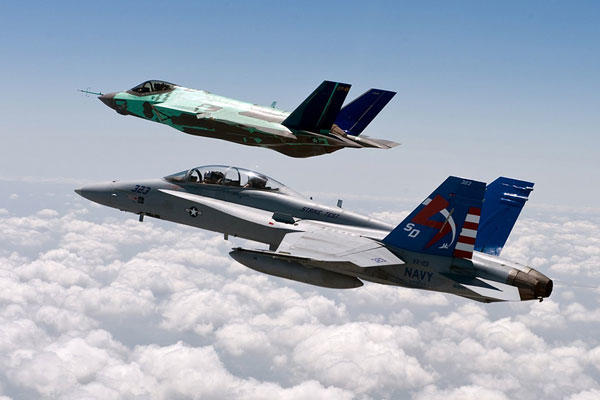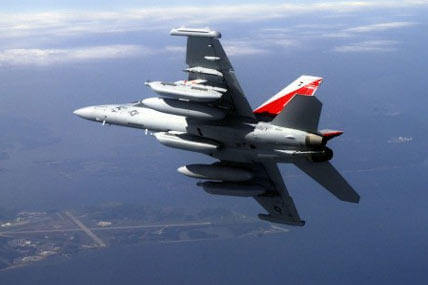A rival aircraft manufacturer has worked not so quietly this past year to offer the Navy an escape hatch from the costly Joint Strike Fighter program.
The Navy's decision to reduce its F-35C five-year acquisition plan from 69 to 36 aircraft over the past year raised questions about the service's commitment to the fifth generation fleet. More questions have been asked since the Navy included 22 EA-18G Growlers on its unfunded priorities list.
Boeing officials started their effort in earnest this past summer at the Paris Air Show to get the Navy to buy more F/A-18 Super Hornets and Growlers as a hedge against problems in the Joint Strike Fighter program, the costliest military acquisition program in U.S. history.
Recently, Boeing has gone as far as to question whether the F-35's stealth technology is still effective against the latest air defense systems being developed in China and Russia. At the Navy League's annual conference earlier this month, Boeing officials did a presentation that discussed the "perishability of stealth."
For its part, Chief of Naval Operations Adm. Jonathan Greenert has repeatedly said the Navy remains committed to the Joint Strike Fighter program and intends to buy more over the next five years.
However, defense analysts have said the recent actions taken by the Navy run counter to the promises offered by the CNO -- specifically the Navy's choice to add 22 Growlers to the 2015 defense budget's unfunded priority list and the push to increase the number of Growlers aboard each aircraft carrier.
There is a reason the U.S. military has allowed the number of its airborne electronic attack platforms to go down over the past decades. The advent of stealth was supposed to make airborne electronic attack unnecessary. The Air Force allowed its last tactical airborne electronic attack aircraft, the EF-111 Raven, to retire and handed the mission over to the Navy.
Mike Gibbons, the company's vice president for the Super Hornet and Growler programs, said the F-35 is not as effective against the wide spectrum of air defense systems as the Growler. The Growler can protect itself and other aircraft from a larger frequency range of systems, Gibbons said.
"The density of the threat is getting more complex and more difficult. The electromagnetic spectrum is getting more complex and more difficult and requires more of what the Growler provides in electronic attack and electronic awareness. Only the Growler has this capability," said Gibbons.
He explained that the Growler must be included in future strike packages in order to protect fifth generation fighters and other assets from air defense systems. Notably, this is a very similar point the CNO has made in recent congressional testimony naming the Growlers a top Navy acquisition priority.
"[Stealth] is needed for what we have in the future for at least 10 years out there and there is nothing magic about that decade," Greenert said. "But I think we need to look beyond that. So to me, I think it's a combination of having aircraft that have stealth but also aircraft that can suppress other forms of radio frequency electromagnetic emissions so that we can get in."
Lockheed Martin executives have countered, saying the F-35 was designed to not require electronic attack support and all of the tests have proven that capability. Loren Thomposon, a defense analyst who has consulted for Lockheed and Boeing, explained that the presence of a Growler nearby a stealthy aircraft such as an F-22 or F-35 could alert an enemy that planes are nearby.
"Although it is a jamming aircraft, the Growler is not stealthy. Knowing that the Growler is present, you would have to assume other aircraft are also nearby -- so it could tip off the enemy as to the presence of other aircraft," Thompson said.
He also pointed out how the Air Force has failed to make any effort to develop a next-generation tactical electronic attack aircraft.
"If a jamming aircraft is needed to support stealthy planes like the F-22 or the F-35, then why isn't the Marine Corps or the Air Force developing a next-generation jamming aircraft? They seem to think that what they are getting in the F-35 will be survivable on its own," he said.
The Joint Strike Fighter does have electronic attack sensors built into it, but few question the Growler's superiority in the realm, especially once the Growler receives the Next Generation Jammer in 2020. Instead of merely sending electromagnetic signals in a particular direction, the Next-Generation Jammer will be able to much more precisely identify, locate and engage specific threats.
Industry sources say the Growler is particularly well suited to counter emerging air defense system threats due to its ability to both jam and detect enemy signals. Air defenses have become more mobile, digital and computerized, industry experts said, making them more difficult for stealthy aircraft to avert, they say.
"The Growler has a wider array of electronic warfare options than any traditional fighter. The Growler itself needs a new jammer because its jammer is antiquated. The basic architecture of the ALQ-99 is antiquated," Thompson said.
However, by the time the Next Generation Jammer is ready, the Boeing production line for the Growler and Super Hornet in St. Louis, Mo., could be shut down. If Boeing does not receive more orders for the F-18, the production line will be shut down in 2019, Gibbons said.
At the moment, there is no funding for Growlers in the fiscal 2015 budget. However, Navy officials have made it a priority to increase the number of Growlers on a carrier from five up to at least seven.
"The 22 aircrafts would enable us to increase five of our carrier air wing squadrons from five aircraft, which is the current program of record, to seven aircraft and give us an additional capability," Vice Adm. Paul Grosklags, the Navy's chief acquisition officer, told Congress last month.
Grosklags added that the 22 additional Growlers are particularly needed because the existing EA-6B aircraft will all be retired in 2019. This is the same year the Navy plans to formally introduce the F-35C to the fleet with the aircraft set to meet its initial operating capability.
The Navy will run a Fleet Battle Experiment this summer to measure the benefit of increased Growler support to strike packages and see if the increased number better defend the carrier in a complex electronic warfare environment, said Navy spokesman Lt. Rob Myers.
The Navy currently has 97 Growlers. The formal program of record calls for 138 Growler aircraft, Myers added. Each Growler costs about $62 million, Boeing officials said.
"The domestic budget for FY15 has no Super Hornets or Growlers so it's very important to us for Congress to act on the request by the Navy for their unfunded requirements. The Navy has communicated that their number one top acquisition priority in that unfunded requirements list are the 22 Growlers. We are eager for Congress to act on that," Gibbons said.
-- Check out Military.com's Equipment Guide to learn more about military aircraft.
-- Kris Osborn can be reached at Kris.Osborn@monster.com and Michael Hoffman can be reached at Mike.Hoffman@monster.com.































